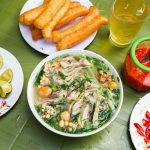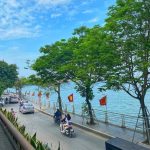Hanoi landmarks get the ice cream treatment
Inspired by a sweet treat abroad, an entrepreneur is whipping up a refreshing wave of local pride with his ice cream bars shaped like Hanoi landmarks.
During the five-day Reunification Day holiday, tourists flocking to Hoan Kiem Lake Walking Street or Thong Nhat Park were captivated by unique ice cream carts. The carts stood out by offering ice cream bars featuring the capital city’s iconic sites.
Each costs VND20,000 (80 cents) and comes in flavors such as young green rice, banana, durian, or mango.
The images of 11 famous Hanoi landmarks make up the ice cream bar collection, including Turtle Tower, the Ho Chi Minh Mausoleum, and the Hanoi Opera House.
 |
|
Ice cream in the shapes of various Hanoi landmarks. Photo courtesy of Gelato Sticks |
Ly Hai Hoang Tan, the creator of these ice cream treats, hails from Hue but currently resides and works in Hanoi. Inspired by ice cream sticks shaped like famous sites in China, Tan aimed to create his own product at an affordable price that represents his adopted home.
“In China, ice cream costs about VND70,000 ($2.75) in Vietnamese currency. This price is not suitable for the Vietnamese market, so we developed ice cream with local flavors, resonating with Vietnamese culture, and priced reasonably,” Tan said.
Tan has been making ice cream since 2018 and began producing ice cream sticks in various shapes in 2021. Starting in early 2023, he introduced ice cream products designed to resemble local landmarks, aiming to contribute to the promotion of local tourism.
To achieve his ice cream bar vision, Tan visited each location he wanted to feature, sketched their shapes using software, and then transferred the designs onto a drawing board.
Next, the shapes were cast into molds. The production process then involved mixing ingredients, pouring them into molds, transferring them to freezers, extracting the ice cream from the molds, and packaging them.
The primary ingredients of these ice cream sticks include ice cream powder imported from Italy, milk powder from Thailand, local fruits for flavors like avocado, durian, cocoa powder from Dak Lak in Vietnam’s Central Highlands, green tea powder from Thai Nguyen in the north, and various jams for fillings.

Tan selected Hanoi as his main focus due to its abundance of famous landmarks and rich history. He plans to expand the range to include ice cream shaped like the Hanoi Railway Station and the Hanoi Flag Tower, with products also in development for other cities such as Ninh Binh, Ho Chi Minh City, and Lao Cai.
The main consumers of these ice cream sticks so far have been young people, tourists, and women who enjoy taking photos. Consumption during the Reunification Day holiday surged approximately threefold compared to regular days.
Twelve-year-old Quang Anh, who purchased ice cream from a mobile cart in the West Lake area, expressed his delight: “I really like this ice cream.”
Recently, various tourist attractions across the country have begun offering these different types of ice cream. Ha Giang Province, Da Lat City, and Ba Den Mountain in Tay Ninh Province all offer ice cream sticks produced by local brands to resemble local landmarks. Customers often take posed photos with the treats before savoring them.
Tan has expressed his intention to expand beyond current offerings, aiming to establish a presence in multiple locations across the country to further contribute to tourism development. He plans to feature local ice cream at both large and small tourism events, and fairs nationwide.
By Tam Anh – VnExpress


















